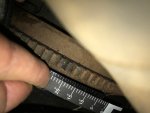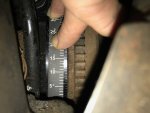Hi Ian,Hi Leconte. Here is a photo of the scale on its bracket riveted to the motor. I would say that you will need to remove the dipstick, ducts, distributor to access it adequately, and still difficult, I suspect. I agree with forumnoreason that you could make/buy a scale and glue it in place. TDC is easy to determine, and the scale can be copied. Mine is accesible at the moment so I'm Happy to copy the degree chart on mine on cardboard and send it to you if that helps Cheers Ian
Can you measure the length along the scale curve between the zero and 30 degrees graduation on your motor? I think it is 68mm or possibly 68.5mm after printing Chris's scale and trying it out on mine. But with all the bits and pieces and my fingers in the way it is hard to be accurate (see picture below). You look like you have clear access at the moment.
Thanks Leconte


